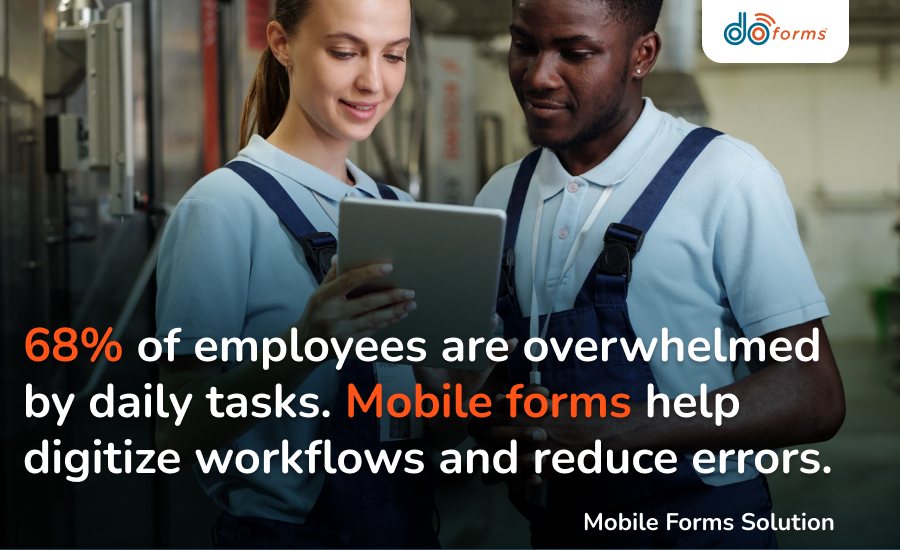
A recent study found that businesses waste 69 workdays due to inefficiency in administrative tasks. This lack of productivity also lost upwards of $5 trillion globally for organizations – and $2.87 trillion of that is within the United States.
But perhaps the most interesting fact was that more than two-thirds of those same workers stated that automating tasks and workflow would improve their productivity and overall time management.
Luckily, there is some good news on the productivity horizon. Additional research has shown that 84 percent of businesses who use mobile forms achieve their total return on investment within two months of implementing them!
In this article, we will dive into what mobile forms are, how they improve workflow automation and productivity, the industries that can benefit from mobile forms, and how you can start creating your own mobile forms to grow your business effectively.
Table of Contents
What Are Mobile Forms?
Mobile forms are electronic records that collect information and send it back to a server for secure digital storage.
Mobile forms work on mobile devices, such as tablets and smartphones, which makes them extremely easy to use. However, they can also be used on desktop computers and traditional web browsers.
Mobile electronic forms can improve many workflow processes that improve productivity and ultimately help businesses grow. Some of these tasks include:
- Merchandising requests
- Inventory management
- Timesheets
- Work orders
- Expense reports
- Inspections
- Invoicing
Most businesses turn to a mobile form apps provider, such as doForms, to build and distribute their mobile forms. doForms, in particular, offers a variety of features within their mobile form services, such as:
- A dedicated mobile application
- Comprehensive reporting systems
- Workforce management capabilities
- GPS location tracking
- HIPPA compliancy
- And more.
What Is Workflow Automation?
Workflow automation is the computerization of a set of historically human-run processes with the goal of improving productivity.
Automating simple yet time-consuming tasks is important because many businesses suffer from inefficient processes that hinder company growth.
For instance, a study from the market research company IDC discovered that businesses lose anywhere from 20 to 30 percent of their revenue due to inefficiency.
Additionally, most chief executive officers spend one-fifth of their work time on tasks which could be automated.
Common tasks that can be automated include:
- Task management.
- Lead generation and management.
- Customer support.
- Invoicing.
- Data and information collection.
As you can see, many workflow automation tasks fall under the mobile form category.
The Benefits Of Mobile Forms For Businesses
Traditional workers take approximately 18 minutes to manually find a document. This can ultimately waste somewhere between 20 percent and 40 percent of their work time.
In addition, professionals can spend half of their time just searching for necessary information.
But integrating mobile form apps into a business’s workflow can improve productivity and achieve a bevy of other business-building benefits.
- Reduces Multi-Tasking
Many workplace professionals might believe that the ability to multi-task is coveted – but the opposite is actually true. Frequently switching between tasks can cost companies 40 percent of their overall productivity.
However, digitized mobile forms can reduce multi-tasking by automating information gathering and storage. Employees are better able to focus their energy on the biggest tasks while leaving information aggregation, storage, reporting and more to workflow automation software like mobile forms.
- Ensures Data Collection and Storage Is Secure
Believe it or not, mobile forms are far more secure than physical paper forms. Providers such as doForms invest in top-of-the-line cybersecurity and encrypted records to ensure that only designated users can access the information.
In addition, mobile forms are held to the highest online security standards – for example, doForms is completely compliant with HIPPA requirements, making it an excellent and safe choice for healthcare providers and patients.
In addition, digitally stored files are safer than physical files. Not only is digital cybersecurity more reliable, but server-stored mobile forms are protected from real-life damage, such as flooding and fire.
- Improves Efficiency
As we mentioned, mobile forms can improve internal productivity. Businesses can collect information quickly, easily and without manual effort, and store or send those documents safely with one click of a button.
What’s more, variations of mobile forms can be used to distribute work orders, which streamlines employee communication. Mobile forms can minimize errors, improve security, and free up team members’ time so they can focus on bigger tasks that drive the company forward into stronger revenue growth.
- Develops Reliable, Fast Data Collection
Ultimately, mobile forms are the fastest and most reliable way to capture relevant data and information. By adhering to strict cybersecurity standards and automizing information collection, businesses can have access to necessary information faster – and possibly in higher quantities.
This will enable companies to improve customer service, analyze data and draw conclusions, and use the information to continually improve the business.
doForms, in particular, provides reliable mobile forms. By using doForms, clients can:
- Collect and access data securely from any device
- Customize forms to collect the information they truly need
- Reduce form errors by automating the process
- Respond to customers in a timely manner
Learn how doForms’ mobile forms and workforce automation solutions can benefit your business HERE.

Which Industries Can Use Mobile Electronic Forms?
Perhaps one of the best things about mobile forms is that nearly every facet of professional work can benefit from mobile forms. Notable industries that use prevalent mobile electronic forms include:
- Healthcare and Pharmaceutical
- Construction
- Automotive
- Engineering
- Manufacturing
- Government
- Education
- Transportation and Logistics
- And more.
For instance, the healthcare and pharmaceutical industry is one of the largest that is currently investing in mobile electric forms and workflow automation – so much so that, before 2027 hits, workflow automation will generate over $900 million in revenue in that industry alone.
However, the prevalence of mobile forms in certain industries does not mean that others are barred from the benefits of mobile forms. In fact, quite the opposite.
A study from McKinsey & Co discovered that upwards of 60 percent of professional occupations can save 30 percent more time by automating tasks, such as lead generation, gathering data, and processing documents.
What’s better? All of these can be improved through mobile forms.
What Is An Example Of A Mobile Form?
Perhaps the most obvious example of a mobile electronic form for regular consumers are the medical records that physicians and nurses use.
Throughout an appointment, healthcare professionals will continually type away at a computer – this is when they are updating your specific electronic record.
At any time, these records can be safely and securely transferred to different offices, doctors and hospitals. In addition, many patients will fill out mobile forms and send them directly to the doctor before an appointment.
Another extremely common example of mobile forms are those used for transportation and logistics.
Have you ever had to sign for a package that was delivered to your front door? That is a mobile forms app in action! Electronic records track your package, who is delivering it, and its delivery status and location.
When you sign for the package through their dedicated mobile app, the information is recorded and transported back to the server. This stores all of the information regarding the transportation and delivery of the item.
How To Create Mobile Forms
The process of creating a mobile form differs, depending on the platform you build your forms on.
But doForms offers an easy-to-use do-it-yourself mobile electronic form builder that can be accessed through either a dashboard or dedicated mobile app.
This DIY mobile form builder is simple. Users just:
- Use a drag and drop feature to customize the information they need to gather.
- Combine questions into specific structures that follow a user-friendly flow.
- Integrate data between mobile devices, office servers, customer relationship management systems, and any other software solutions they have. This syncs data and ensures all employees have access to the latest information.
- Specify the preferred language, such as English, Italian, Spanish, or another language.
- Distribute mobile electronic forms to customers as a PDF, Excel, or Word Doc with one click of a button.
Plus, users only need to build a mobile form once in doForms. After that, they can use it over and over again seamlessly.
It is important to note that not all mobile forms serve the same purpose. For instance, doForms offers two main types of mobile form: Mobile Forms Solutions and Workforce Management Forms.
Try doForms free 30-day trial HERE and create your own customized mobile form!
Mobile Forms Solutions
Mobile forms solutions are dedicated software solutions that enable professional organizations to create and distribute mobile electronic forms to customers, employees and third-party vendors.
These recipients are then able to electronically fill out the information and send it back to the company safely and securely.
Reputable mobile forms providers, such as doForms, safely store this data in cloud-based storage. doForms, in particular, also runs analytical reports and provides insights within users’ doForms dashboard.
Workforce Management Forms
Workforce management forms are geared more towards internal productivity. They dispatch new assignments to team members, track locations and progress, and more through dedicated mobile forms.
For instance, many businesses have field employees – such as automotive plants – or contract third-party vendors to fulfill tasks, like customer deliveries.
However, when workers are scattered and/or constantly changing location, it can be difficult to track progress and provide new tasks. Workforce management forms allow businesses to:
- Track GPS locations.
- Build employee schedules.
- Send work orders and know when an employee views a new work order.
- Fill in and view completed mobile forms.
- And more.
Can Mobile Forms Apps Be Used To Collect Information And Data?
In short – yes! Mobile forms apps can collect information and data. In fact, that is their main purpose.
Now, this may seem like a silly question to some. But mobile forms are a foreign concept to many business leaders. For some, it can be difficult to reconcile the differences between a digital form created on a desktop, and a form built from the palm of your hand in a mobile app.
However, the reality is that both types of digital forms function similarly. The difference is only the device with which you create it.
The beauty of mobile forms is that they can be created anytime, anyplace, anywhere. This empowers businesses to handle workflow automation and data collection more efficiently and with greater flexibility. This ultimately increases revenue.
As an example, doForms has a dedicated mobile application that users can download. Should they choose to utilize the app, they will be able to create custom mobile electronic forms from a smartphone or tablet and send them to applicable recipients as easily as they can from a desktop computer.
In addition, the recipients of those forms – whether they are customers or fellow employees – will also be able to fill out and return those forms from a mobile device, if they so choose.
Not only can mobile forms apps collect relevant information, but they can also transport it quickly and securely back to the business, far surpassing the data security and speed of mailing physical papers.
How Mobile Electronic Forms Can Automate Workflow
All in all, mobile forms can automate workflow in a variety of businesses, industries and occupations with simplicity.
Strategic mobile forms provide many business-building benefits, such as:
- The automation of information gathering and distribution
- The reduction of multi-tasking
- Safe and secure data collection, distribution and storage
- Reliable and fast data collection
- Improved productivity
In addition, the best mobile electronic forms providers, such as doForms, offer many helpful features, which include:
- Customizable mobile form interfaces.
- A dedicated mobile application.
- Comprehensive reporting systems.
- Workforce management capabilities.
- GPS location tracking.
- The ability to build employee schedules.
- Sending work orders and knowing when an employee views a new work order.
- The ability to integrate data between mobile devices, office servers, customer relationship management systems, and any other software solutions they have.
- Various language preferences, including English, Italian, Spanish, and more.
- HIPPA compliancy.
- Secure data collection, storage and distribution from any device.
- And more!
By utilizing mobile forms to automate workflow and information aggregation, businesses like yours will improve their internal productivity, boost, customer service, and scale their businesses more effectively as a result.




